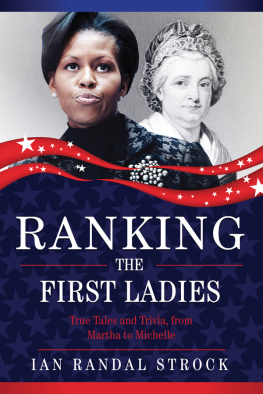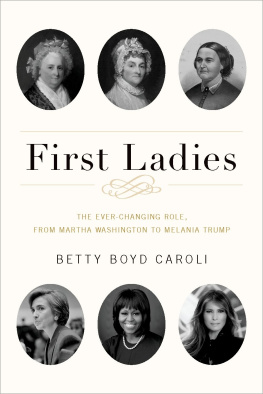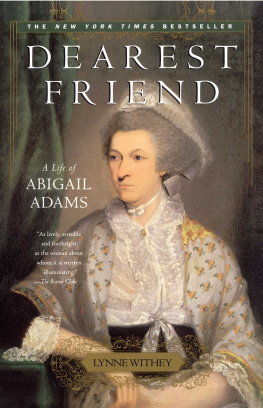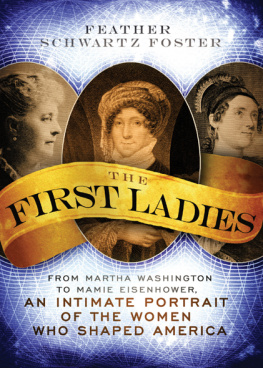First Ladies of the Republic
First Ladies of the Republic
Martha Washington, Abigail Adams, Dolley Madison, and the Creation of an Iconic American Role
Jeanne E. Abrams

New York University Press
New York
NEW YORK UNIVERSITY PRESS
New York
www.nyupress.org
2018 by New York University
All rights reserved
Book designed and typeset by Charles B. Hames
References to Internet websites (URLs) were accurate at the time of writing. Neither the author nor New York University Press is responsible for URLs that may have expired or changed since the manuscript was prepared.
Library of Congress Cataloging-in-Publication Data
Names: Abrams, Jeanne E., 1951 author.
Title: First ladies of the republic : Martha Washington, Abigail Adams, Dolley Madison, and the creation of an iconic American role / Jeanne E. Abrams.
Description: New York : New York University Press, 2018. | Includes bibliographical references and index.
Identifiers: LCCN 2017034128 | ISBN 9781479886531 (cl : alk. paper)
Subjects: LCSH: Presidents spousesUnited StatesBiography. | Washington, Martha, 17311802. | Adams, Abigail, 17441818. | Madison, Dolley, 17681849.
Classification: LCC E176.2 .A27 2018 | DDC 973.09/9 [ B ] dc23
LC record available at https://lccn.loc.gov/2017034128
New York University Press books are printed on acid-free paper, and their binding materials are chosen for strength and durability. We strive to use environmentally responsible suppliers and materials to the greatest extent possible in publishing our books.
Manufactured in the United States of America
10 9 8 7 6 5 4 3 2 1
Also available as an ebook
Contents
When George Washington was inaugurated as the first president of the United States on April 30, 1789, King George III and Queen Charlotte occupied the throne in Great Britain. Queen Charlotte had been raised as a princess in a small German duchy, and the proposed royal union was cemented only after intense secret negotiations. Charlotte met her future husband just hours
For their official coronation at Londons Westminster Abbey, just two weeks after their marriage, the English royal couple were decked out in elaborate costumes, and
Washington entered into the marriage by mutual consent without the need for the outside official negotiations that characterized royal marriages.
Although the Washingtons had never traveled to England, in his earlier years one of Georges highest aspirations had been to become a respected Englishman, one who reflected British values and displayed unwavering loyalty to the crown. Washington had always been an avid reader, and as a young man, he had undoubtedly read popular newspaper and magazine accounts about King Georges coronation, so he was likely familiar with the rituals surrounding European royalty. And after his election as president, Washington had two close advisers at his side, both of whom had firsthand experience at the European courts. John Adams, the new vice president, had served as a United States emissary first to France and then later to the English Court of St. James, and Thomas Jefferson, appointed the first secretary of state, had returned to America from Paris at the end of 1789, after having spent five years as the minister to France then under the reign of Louis XVI.
When Martha later joined the newly elected president during May 1789 in the The glittering canopy at Queen Charlottes coronation was sewn of cloth of gold. As the original First Lady of the United States, as the position would later become known, Martha Washington had to create her new quasi-official role from whole cloth.
Despite the fact that the role of First Lady was not an elected position, Martha and her two successors, First Ladies Abigail Adams and Dolley Madison, would all come to symbolize the heart and character of their husbands administrations. Never officially authorized, nevertheless, the position of First Lady became a highly influential role in American history. These three women were responsible for essentially creating the role of First Lady without having a roadmap to follow. To do so, they often had to walk a social and political tightrope. None of the three could simply imitate the role of European queens; instead, they each had to construct a unique and distinctively American style as the partner of the young nations leading political figure, the president.
Forging the Role of First Lady
I have lived to witness changes, such as I could never have imagined.
A BIGAIL A DAMS to Catherine Nuth Johnson, August 20, 1800
Martha Washington, Abigail Adams, and Dolley Madison, the inaugural First Ladies of the United States of America, created a role that was uniquely American in both its style and substance. Each of them shaped the role of First Lady by placing their own imprint upon the position, but at the same time they learned from one another as they sought a path that would blend their roles as women, wives, mothers, and public figures. With no precedent to follow, Martha, Abigail, and Dolley began to construct the position of the presidents spouse, often consciously working to make it distinct from that of consorts in European courts and aligning it more closely with emerging republican ideals and standards for presidential behavior.
In the American imagination, at the time Europe was viewed as the site of monarchial and aristocratic displays of power. That perception played an overarching role in the quest to define the roles that the wives and daughtersas sometimes serving lemonade instead of fine wine, took on such significance.
To this day, the role of First Lady has no official mandate, and while in practice it was and is ofttimes a very constraining and conservative position, it continues to hold the females among the early political social elite in the United States. To examine their political involvement demands that we view their endeavors against the backdrop of their times and not with a presentist lens.
This book examines the marital partnerships of Americas first three presidential couples, but it especially focuses on the prominent roles of Martha Washington, Abigail Adams, and Dolley Madison in their years as the nations earliest First Ladies. Martha Jefferson died at the young age of twenty-seven and never stood beside her husband as First Lady. Thomas Jeffersons daughter Martha Jefferson Randolph sometimes supported her father as a substitute, but it was really Dolley Madison who experienced an internship as First Lady, so to speak, during Jeffersons two terms in office.
The stories of Americas first three presidential spouses have received attention in countless volumes since the days in which they occupied their pioneering positions. However, we now have the opportunity to reassess their roles and ask new questions about their levels of political impact, and we can ask what Martha, Abigail, and Dolleyand other early elite American women who were related to significant political figuresmight have done similarly or differently from one another as well as from their counterparts in Europe. After all, Europe, especially England and France, was the primary point of reference for early Americans. For example, female royal figures and French female salonnires have achieved perhaps a mythical status in the American imagination, but were they indeed as influential as first thought?
Moreover, it might be more fruitful to look at the key players in the new American political order after the American Revolution as a family unit rather than as individuals. Certainly, in the case of the Washingtons, the Adamses, and the Madisons, they operated more visibly as a partnership than as a male/female binary divide. Martha, Abigail,








